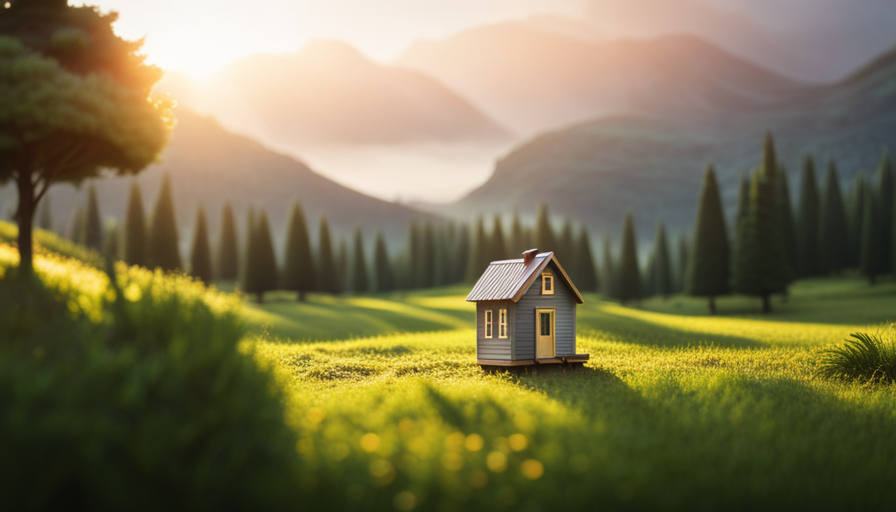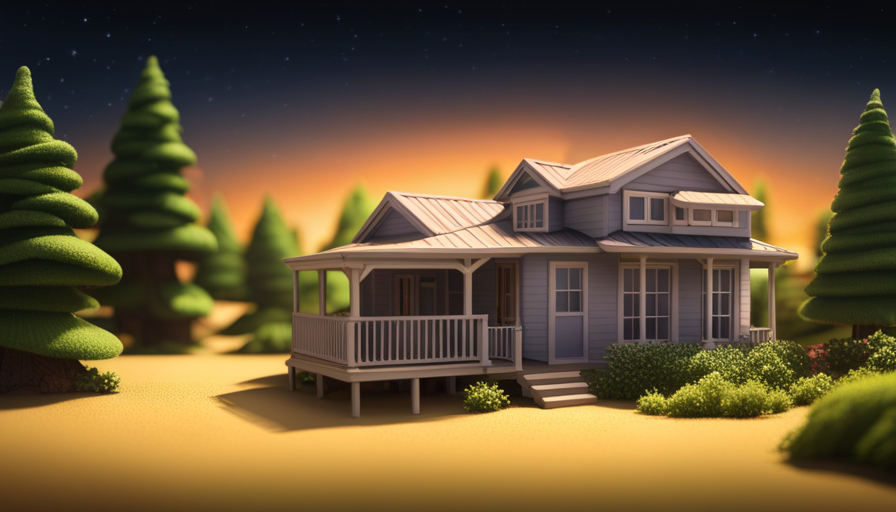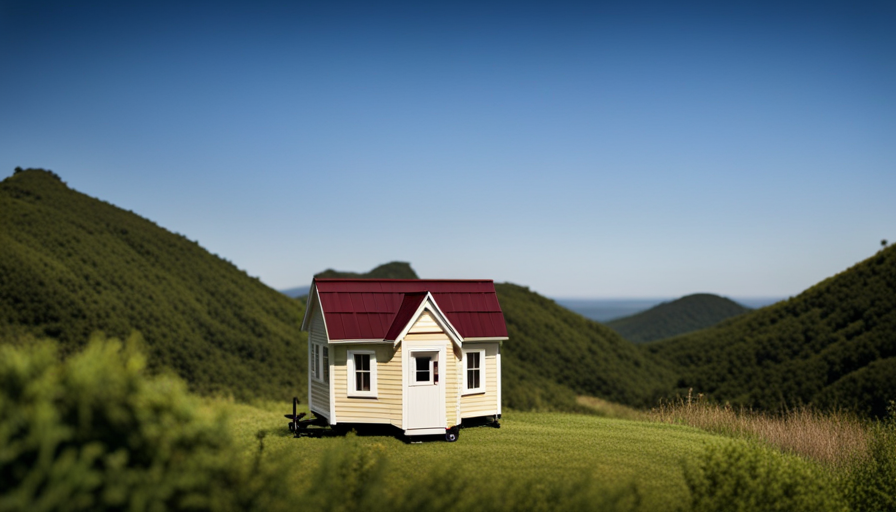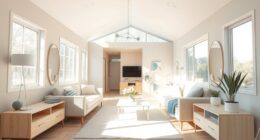In a culture that often associates big with better, I have found solace in the charm of living on a smaller scale. Like a cozy retreat embraced by nature, a tiny home offers a sustainable and fulfilling lifestyle that is liberating. If you have ever wanted to simplify your life, reduce your carbon footprint, and embrace minimalism, then choosing a tiny house might be the perfect option for you.
But where do you begin? In this article, I will guide you through the journey of acquiring your very own tiny house. From researching different styles and designs to customizing the layout and features, I will provide you with the detailed steps and information you need to make this dream a reality.
So, let’s dive in and discover how to embark on the tiny house adventure of a lifetime.
Key Takeaways
- Research various styles and designs of tiny houses to determine what suits your preferences and needs.
- Consider your budget and explore financing options, such as self-financing, traditional home loans, personal loans, or crowdfunding.
- Find a suitable location for your tiny house, taking into account amenities, zoning regulations, utilities, and cost.
- When building or buying a tiny house, consider customization options, cost savings, learning experiences, and sustainability factors.
Research Tiny House Styles and Designs
If you’re ready to take the plunge into the world of tiny living, you’ll be amazed by the endless possibilities and creativity that come with exploring different styles and designs for your dream tiny house.
One of the most exciting aspects of designing a tiny house is the opportunity to maximize every inch of space. When it comes to the interior, you’ll want to carefully consider the layout and functionality of your tiny house. Think about how you will use each room and what your priorities are. Will you need a separate sleeping area, or would you prefer a loft bed to save space? Do you want an open concept living area or separate rooms? These are all important questions to ask yourself when planning your tiny house interior.
In addition to the layout, storage is a crucial component of tiny house design. With limited square footage, it’s important to get creative with storage solutions. Consider built-in shelves, hidden storage compartments, or multi-functional furniture to make the most of your space. Utilizing vertical space is also key. Think about using wall-mounted storage options or incorporating storage into your staircase.
Now that you have an idea of what you want for your tiny house interior and storage, it’s time to determine your budget and financing options.
Determine Your Budget and Financing Options
Once you’ve ascertained your financial constraints and explored potential funding alternatives, it’s crucial to establish a realistic budget for your diminutive abode.
Determining an appropriate budget for your tiny house project requires careful consideration of various factors. One of the first steps is to explore different financing options available for tiny houses. There are several pros and cons associated with each option.
For instance, if you have enough savings, self-financing allows you to avoid interest payments and maintain full control over your project. However, this may not be feasible for everyone. Other options include traditional home loans, personal loans, or crowdfunding. Each option comes with its own set of advantages and disadvantages, such as interest rates, repayment terms, and required documentation.
To determine an appropriate budget, it’s important to consider both the fixed costs and variable costs. Fixed costs include the purchase or construction of the tiny house itself, land acquisition, permits, and inspections. Variable costs encompass ongoing expenses like utilities, maintenance, and insurance. It’s essential to research and gather estimates for each component to ensure an accurate budget.
Transitioning into the next section, deciding between building or buying a tiny house requires a thorough evaluation of your budget and personal preferences.
Decide Between Building or Buying a Tiny House
When deciding between building or buying a tiny house, you should carefully consider your budget and personal preferences. There are pros and cons to both options, and factors to consider that will help you make the best decision for your situation.
Pros of Building a Tiny House:
- Customization: Building your own tiny house allows for complete customization, ensuring that every inch of the space is tailored to your needs and preferences.
- Cost Savings: Building a tiny house can be more cost-effective than buying one, especially if you’re able to do some of the work yourself or use salvaged materials.
- Learning Experience: Building a tiny house can be a rewarding and educational experience, allowing you to learn new skills and gain a sense of accomplishment.
- Sustainability: Building your own tiny house gives you the opportunity to incorporate eco-friendly features and materials, reducing your carbon footprint.
Cons of Building a Tiny House:
- Time and Effort: Building a tiny house can be a time-consuming and labor-intensive process, requiring a significant investment of time and effort.
- Skill Level: Building a tiny house requires a certain level of construction knowledge and skills, which may be a barrier for those without experience.
- Financing Challenges: Securing financing for building a tiny house can be more challenging compared to buying one, as traditional lenders may be hesitant to provide loans for unconventional housing options.
- Legal Considerations: Building codes and zoning regulations can vary, and navigating the legal aspects of building a tiny house can be complex.
Considering these pros and cons, as well as your budget and personal preferences, will help you determine whether building or buying a tiny house is the right choice for you. Once you’ve made this decision, the next step is to find a suitable location for your tiny house.
Find a Suitable Location for Your Tiny House
To truly make your tiny dream a reality, you need to scout out the perfect spot that will not only accommodate your unique lifestyle but also enhance it. Finding suitable land for your tiny house can be a challenge, but with careful planning and research, you can find the ideal location. Here are some key factors to consider when looking for land for your tiny house:
| Factors to Consider | Description |
|---|---|
| Location | Is the land close to amenities and services you need? Is it in a safe and desirable neighborhood? |
| Zoning regulations | Check local zoning regulations to ensure that tiny houses are allowed in the area. Look for land in areas with flexible zoning or specific regulations for tiny houses. |
| Utilities | Consider access to water, electricity, and sewage. Are these services available on the land or will you need to install them? |
| Cost | Determine your budget and consider the cost of the land, including any necessary improvements or infrastructure. |
Finding the perfect spot for your tiny house is just the first step. Once you have identified a suitable location, the next step is to obtain the necessary permits and licenses to legally park or build your tiny house there.
Obtain the Necessary Permits and Licenses
Make sure you’ve got all the necessary permits and licenses in order to turn your tiny house dreams into a reality! The permit application process and local zoning regulations are crucial factors to consider when embarking on your tiny house journey.
Before starting any construction, it’s essential to research and understand the specific requirements set by your local government. This typically involves filling out an application, providing detailed plans and specifications, and paying any associated fees. The permit application process may also involve inspections and consultations with local authorities to ensure compliance with building codes and regulations.
Local zoning regulations play a significant role in determining where you can place your tiny house. These regulations vary from one area to another and may include restrictions on the size, height, and location of your tiny house. Some areas may also require you to obtain additional permits, such as septic or electrical permits, depending on your specific circumstances. It’s vital to thoroughly review and understand these regulations to avoid any legal issues or setbacks during the construction process.
Once you’ve obtained the necessary permits and licenses, you can move on to the next step of hiring a professional builder or contractor (if applicable). This step will ensure that your tiny house is constructed properly and in compliance with all building codes and regulations.
Hire a Professional Builder or Contractor (if applicable)
If you’re ready to bring your vision to life, consider enlisting the expertise of a skilled builder or contractor to ensure a seamless construction process and a high-quality end result. Hiring professionals can save you time, energy, and potentially costly mistakes.
While some individuals may opt for a DIY building approach, it’s important to recognize the benefits that professionals bring to the table. They have the knowledge and experience to navigate the complexities of building codes, permits, and regulations, ensuring that your tiny house is up to standard. Moreover, professionals have access to specialized tools, materials, and techniques that can enhance the structural integrity and overall aesthetics of your tiny house.
By hiring a professional builder or contractor, you can tap into their network of suppliers and subcontractors, streamlining the construction process. They can provide valuable insights and suggestions based on their expertise, helping you make informed decisions about design, layout, and materials. Additionally, professionals can handle the coordination and management of the construction project, alleviating the stress and responsibilities that come with overseeing the entire process yourself.
As you think about hiring a professional, keep in mind that customization is a key aspect of tiny house living.
In the next section, we will explore how you can customize your tiny house layout and features to suit your unique needs and preferences.
Customize Your Tiny House Layout and Features
Embrace your creativity and tailor the layout and features of your tiny abode to reflect your unique style and needs. Customizing your tiny house layout allows you to maximize space utilization and create a functional and aesthetically pleasing interior. Here are four ways to design your dream tiny house:
- Multi-purpose furniture: Opt for furniture pieces that serve multiple functions, such as a sofa that can be converted into a bed or a dining table with built-in storage compartments. This helps save space and adds versatility to your living area.
- Smart storage solutions: Utilize every nook and cranny by incorporating clever storage solutions. Consider installing shelves, cabinets, and drawers in unused spaces like under the stairs or above the kitchen cabinets. This will help keep your belongings organized and maximize the available space.
- Open floor plan: Opt for an open concept layout that eliminates unnecessary walls and creates a sense of spaciousness. This allows for better flow and makes your tiny house appear larger than it actually is.
- Natural light: Incorporate large windows and skylights to let in ample natural light. This not only makes your tiny house feel brighter and more welcoming, but it also helps create the illusion of a larger space.
By customizing your tiny house layout and features, you can design a space that perfectly suits your lifestyle. Now, let’s consider off-grid living options such as solar power and composting toilets.
Consider Off-Grid Living Options (e.g., solar power, composting toilets)
Consider going off the grid and harnessing the power of the sun with solar panels, transforming your tiny abode into a shining beacon of sustainable energy. Embracing off-grid living options not only reduces your carbon footprint but also provides you with the freedom to live independently.
Solar power is an excellent choice for sustainable energy, as it allows you to generate electricity without relying on traditional power grids. Installing solar panels on your tiny house will enable you to power your appliances, charge your devices, and light up your living space with clean, renewable energy.
In addition to solar power, another important aspect of off-grid living is waste management. Traditional plumbing systems may not be suitable for tiny houses, so considering composting toilets can be a practical and eco-friendly solution. Composting toilets break down waste into compost material that can be used as fertilizer. They require minimal water usage and eliminate the need for expensive septic systems.
By incorporating these sustainable energy options and waste management solutions into your tiny house, you can live a more environmentally conscious lifestyle. Transitioning into the subsequent section about moving into your tiny house and starting the tiny life, you’ll be equipped with the necessary tools to live off-grid and enjoy the benefits of self-sufficiency and sustainability.
Move into Your Tiny House and Start Living the Tiny Life
Take the leap and embark on your tiny living journey, moving into your compact sanctuary and embracing a life of simplicity and sustainability.
Once you’ve completed the construction or purchase of your tiny house, it’s time to make the big move. Before you begin packing up your belongings, create a move-in checklist to ensure a smooth transition. This checklist should include items such as transferring utilities, setting up mail forwarding, and organizing your storage solutions to maximize space efficiency.
When it comes to decorating your tiny house, it’s important to keep in mind that less is more. Opt for furniture that’s multifunctional and space-saving, such as a sofa that doubles as a storage unit or a foldable dining table. Utilize vertical space by installing shelves or hooks on the walls for additional storage options. Choose a color scheme that’s light and neutral to create an illusion of more space.
As you settle into your tiny house, embrace the benefits of minimalism and sustainable living. Transitioning to a smaller living space encourages you to declutter and prioritize what truly matters to you. Additionally, living in a tiny house promotes energy efficiency and reduces your carbon footprint. Embrace this lifestyle change and enjoy the simplicity and sustainability that comes with it.
Embrace the Benefits of Minimalism and Sustainable Living
Step into the world of simplicity and sustainability, where every possession serves a purpose and clutter becomes a distant memory. Embracing a minimalist lifestyle and sustainable living is a key aspect of the tiny house movement.
Living in a tiny house means consciously making choices about what we bring into our homes and how we use our resources.
One of the main benefits of adopting a minimalist lifestyle is the freedom it brings. By living with less, we free ourselves from the burden of excess possessions and the constant need to acquire more. We learn to appreciate the things that truly matter to us and let go of the rest. This shift in mindset allows us to focus on experiences and relationships rather than material things.
In addition to the personal benefits, minimalism also has a positive impact on the environment. By living in a tiny house, we reduce our carbon footprint and promote eco-friendly living. Tiny houses require fewer resources to build and maintain compared to traditional homes. The smaller living space encourages us to consume less and be more mindful of our energy usage.
Embracing minimalism and sustainable living is a conscious choice that aligns with our values and priorities. It’s a lifestyle that promotes simplicity, mindfulness, and respect for the environment. By adopting these principles, we not only create a more fulfilling life for ourselves but also contribute to a more sustainable future for all.
Frequently Asked Questions
What are the legal requirements for living in a tiny house?
To live in a tiny house, I need to be aware of the legal requirements and regulations. These include zoning laws, building codes, and permits. It is important to research and comply with these regulations to ensure a legal and safe living situation.
How do I find a reputable builder or contractor for my tiny house?
When finding reputable builders or contractors for my tiny house, I use the technique of coincidence. By comparing prices and exploring different options, I ensure that I make an informed decision.
Are there any zoning restrictions or regulations for placing a tiny house on my property?
Yes, there are zoning restrictions and regulations that govern the placement of a tiny house on your property. It is important to check with your local government to understand the specific requirements and obtain any necessary building permits.
How do I connect utilities such as electricity and water to my tiny house?
Connecting utilities to my tiny house involves installing a water connection and electrical hookup. Plumbing requires a water line connection and a drain system. Electrical wiring must be installed by a professional to ensure safety and compliance with regulations.
What are the maintenance costs associated with owning a tiny house?
The maintenance costs of owning a tiny house can vary depending on factors such as location, materials used, and size. Additionally, it is essential to consider purchasing tiny house insurance to protect against unexpected damages and liabilities.
Conclusion
In conclusion, embarking on the journey of getting a tiny house requires thorough research and careful consideration. By exploring various styles and designs, determining your budget, and deciding between building or buying, you can find the perfect fit for your needs.
Obtaining permits and licenses, customizing the layout, and considering off-grid living options will further enhance your tiny house experience. Embracing the benefits of minimalism and sustainable living will allow you to live a fulfilling and eco-conscious life.
So, seize the opportunity to simplify, sustain, and savor the serenity of tiny living!
I’m Theodore, and I love tiny houses. In fact, I’m the author of Tiny House 43, a book about tiny houses that are also tree houses. I think they’re magical places where imaginations can run wild and adventures are just waiting to happen.
While tree houses are often associated with childhood, they can be the perfect adult retreat. They offer a cozy space to relax and unwind, surrounded by nature. And since they’re typically built on stilts or raised platforms, they offer stunning views that traditional homes simply can’t match.
If you’re looking for a unique and romantic getaway, a tree house tiny house might just be the perfect option.










